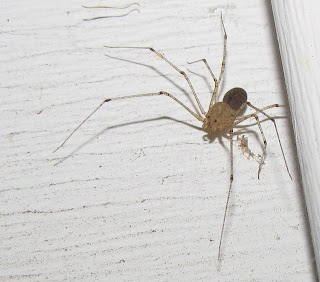Many spiders are “built” to fit their habitat and lifestyle, and perhaps none are better examples than the slender crab spiders of the genus Tibellus, family Philodromidae. They hunt by lying in ambush on grasses or foliage. Their distinctive long body and vertical striped pattern camouflage them almost perfectly. They are not alone, however, as several other spiders share similar coloration and it is easy to confuse them all.
Pictured above is a Tibellus I found in North Cheyenne Cañon, Colorado Springs, Colorado, earlier this week. Had it not been on a green leaf, I probably would have overlooked it easily. Note that this is not a particularly large spider. There are seven species of Tibellus in North America north of Mexico, and adult females collectively range from 6-11 millimeters in body length. Males are slightly smaller, 5-8 millimeters. Pictured below is a juvenile nursery web spider, Pisaurina mira. It will eventually become much larger, as adult females are 12.5 to 16.5 millimeters, males 10.5-15 millimeters. These spiders prowl the same habitats as Tibellus, and adopt a similar resting posture. Pisaurina are more robust in their overall appearance, however, a bit hairier, and have a different eye arrangement.
Another genus that may be confused with slender crab spiders is Thanatus, also in the family Philodromidae. The first two images in my ”Spring Spiders” post are of a specimen of Thanatus. Note the more robust appearance and the difference in the pattern of stripes compared to Tibellus. Both spiders are of similar size, but Thanatus hunts mostly on the ground amid grasses and weeds, whereas Tibellus is almost always found on stems, stalks, grassblades, or leaves.
Lastly, the Striped Lynx Spider, Oxyopes salticus, can sometimes be mistaken for Tibellus. Below is an example I found near Chicago, Illinois. Note the very long spines on the legs, and the more scrunched-up posture as it waits in ambush on a grass stem. Lynx spiders have a longer “face,” too, whereas slender crab spiders have an overall more flattened appearance.
Female slender crab spiders are good mothers. They spin a flattened egg case which they guard religiously until the spiderlings emerge. Here is one I found in Tucson, Arizona. I maneuvered the grassblade several times for better light exposure and she never even flinched.
Do keep an eye out for these amazing grass-mimics. You may find still other spiders, even orb weavers, with nearly identical shapes and patterns in the process of looking for Tibellus. Try using a sweep net if you can’t find one otherwise. You’d be astonished at the diversity of arthropods in a “disturbed habitat” like a vacant lot.
Sources: Balaban, John and Jane, et al. 2004. “Genus Tibellus - Slender Crab Spiders,” BugGuide.net
Kaston, B. J. 1978. How to Know the Spiders (3rd ed.). Dubuque, Iowa: Wm. C. Brown Company Publishers. 272 pp.
Ubick, D., P. Paquin, P. E. Cushing, and V. Roth, eds. 2005. Spiders of North America: an identification manual. American Arachnological Society. 377 pp.















